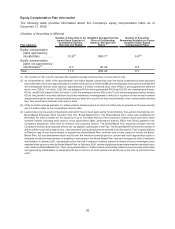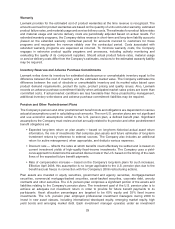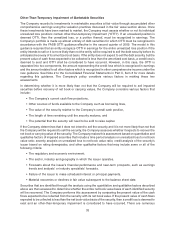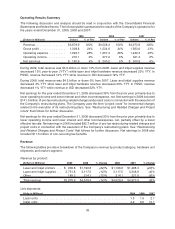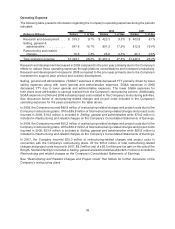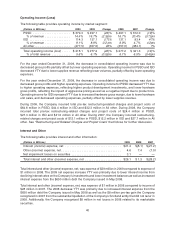Lexmark 2009 Annual Report Download - page 38
Download and view the complete annual report
Please find page 38 of the 2009 Lexmark annual report below. You can navigate through the pages in the report by either clicking on the pages listed below, or by using the keyword search tool below to find specific information within the annual report.that are less observable in the market, the determination of fair value requires more judgment. Such
measurements are generally classified as Level 3 within the fair value hierarchy.
Fair value measurements of assets and liabilities are assigned a level within the fair value hierarchy based
on the lowest level of any input that is significant to the fair value measurement in its entirety. In determining
where measurements lie in the fair value hierarchy, the Company uses assumptions regarding the general
characteristics of each type of investment as the starting point. The Company then downgrades individual
investments to a lower level as necessary based on specific facts and circumstances, such as a security
becoming distressed or a decrease in pricing inputs.
Uncertainty in the capital markets has presented additional challenges with respect to valuing certain
investments the Company holds. In the case of auction rate securities in which auctions were
unsuccessful, observable pricing data was not available resulting in the Company performing a
discounted cash flow analysis based on assumptions that it believes market participants would use
with regard to such items as expected cash flows and discount rates adjusted for liquidity premiums. The
Company refined its methodology for valuing its auction rate securities in 2009 and made changes to
certain assumptions significant to the valuation including (1) the auction rate market will remain illiquid and
auctions will continue to fail causing the interest rate to be the maximum applicable rate and (2) the
securities will not be redeemed. These assumptions resulted in discounted cash flow analysis being
performed through the legal maturities of these securities, ranging from the year 2032 through 2040, or in
the case of the auction rate preferred stock, through the mandatory redemption date of year-end 2021. In
contrast, at year-end 2008, the company assumed redemption dates in the year 2010 for these securities.
Though the change in assumptions did result in lower fair values for these securities, the fair value
adjustments were not material to the Company’s overall marketable securities portfolio. Valuation of these
securities as well as a smaller number of distressed debt securities and certain asset-backed and
mortgaged-backed securities can be very subjective. Estimates and assumptions could be revised in
the future depending on market conditions and changes in the economy.
In April 2009, the FASB issued guidance for determining fair value when the volume and level of activity for
the asset or liability have significantly decreased and identifying transactions that are not orderly. In
response to the guidance, the Company has added additional steps, starting in the second quarter of 2009,
to its fair value practices described above with respect to the consensus pricing methodology used in the
valuation of most of the securities in which it has invested. The Company has implemented more
comprehensive procedures to review the number of pricing inputs received as well as the variability in
the pricing data utilized in the overall valuation. For securities in which the number of pricing inputs used is
less than expected or there is significant variability in the pricing inputs, the Company has tested that the
final consensus price is within a reasonable range of fair value through corroboration with other sources of
price data. The Company will likely continue to refine its fair value assurance procedures as it pursues
more cost-effective methods of obtaining such assurances in the future. See Note 2 to the Consolidated
Financial Statements in Part II, Item 8 for more information regarding the fair value accounting guidance
issued in 2009.
Effective January 1, 2009, the Company began applying the valuation concepts of the fair value
measurements guidance to its nonrecurring, nonfinancial fair value measurements. These
measurements are most often based on inputs or assumptions that are less observable in the market,
thus requiring more judgment on the part of the Company in estimating fair value. Determination of the
most advantageous market (when no principal market exists) and the highest and best use of an asset
from the perspective of market participants can result in fair value measurements that differ from estimates
based on the Company’s specific intentions for the asset.
See Note 3 to the Consolidated Financial Statements in Part II, Item 8 for more information regarding the
Company’s fair value measurements and valuation practices.
32


